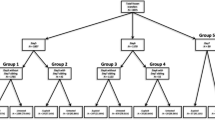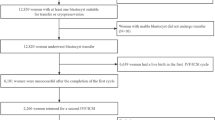Abstract
Background
Premature luteinization of one or more developing follicles complicates 1–2 % of controlled ovarian stimulation cycles for assisted reproduction. The management of this complication is controversial, with cycle cancellation likely representing the most commonly used strategy. The aim of this study was to evaluate the efficacy of the “freeze-all” policy—where the entire cohort of blastocysts is cryopreserved for subsequent frozen-thawed embryo transfer—in treating cases of premature luteinization.
Methods
Patients experiencing premature luteinization during controlled ovarian stimulation—identified by extremely high progesterone levels at induction (P levels ≥3.0 ng/ml and/or P/estradiol ratio ≥1, n = 42)—were included in a “freeze-all” program and compared to controls undergoing a “freeze-all” program with normal progesterone levels at induction (P < 1.5 ng/ml, n = 67).
Results
Blastulation rate was comparable between patients with premature luteinization and controls (48.1 ± 20.5 % in Cases vs. 52.3 ± 24.9 % in Controls, p = 0.36). Ongoing pregnancy rates after the first frozen-thawed embryo transfer (38.1 % in Cases and 41.0 % in Controls, p = 0.83) and cumulative ongoing pregnancy rates after three frozen-thawed embryo transfer cycles (40.5 % in Cases vs. 47.8 % in Controls, p = 0.55) were also similar.
Conclusions
These results show that extremely marked progesterone elevation throughout controlled ovarian stimulation does not impair blastocyst development and implantation potential in the context of a “freeze-all” strategy. Based on this, adoption of the “freeze-all” strategy represents a valuable tool in treating premature luteinization. In contrast, cycle cancellation—likely the most frequently used method for management of this complication—currently represents a misconduct.
Similar content being viewed by others
Abbreviations
- AMH:
-
Anti-mullerian hormone
- BMI:
-
Body mass index
- CI:
-
Confidence interval
- COS:
-
Controlled ovarian stimulation
- E 2 :
-
17β estradiol
- FET:
-
Frozen-thawed embryo transfer
- FSH:
-
Follicle-stimulating hormone
- GnRH:
-
Gonadotropin-releasing hormone
- HAS:
-
Human serum albumin
- hCG:
-
Human chorionic gonadotropin
- HP-hMG:
-
Highly purified human menopausal gonadotropin
- ICSI:
-
Intracytoplasmic sperm injection
- IVF:
-
In vitro fertilization
- MII:
-
Metaphase II
- OHSS:
-
Ovarian hyperstimulation syndrome
- OR:
-
Odds ratio
- P:
-
Progesterone
- rFSH:
-
Recombinant FSH
- rLH:
-
Recombinant luteinizing hormone
- SD:
-
Standard deviation
- SSS:
-
Serum substitute supplement
References
Bosch E, Valencia I, Escudero E, Crespo J, Simón C, Remohí J, Pellicer A (2003) Premature luteinization during gonadotropin-releasing hormone antagonist cycles and its relationship with in vitro fertilization outcome. Fertil Steril 80(6):1444–1449
Huang Y, Wang EY, Du QY, Xiong YJ, Guo XY, Yu YP, Sun YP (2015) Progesterone elevation on the day of human chorionic gonadotropin administration adversely affects the outcome of IVF with transferred embryos at different developmental stages. Reprod Biol Endocrinol 13:82
Roque M, Valle M, Guimarães F, Sampaio M, Geber S (2015) Freeze-all policy: fresh vs. frozen-thawed embryo transfer. Fertil Steril 103(5):1190–1193
Venetis CA, Kolibianakis EM, Bosdou JK, Tarlatzis BC (2013) Progesterone elevation and probability of pregnancy after IVF: a systematic review and meta-analysis of over 60 000 cycles. Hum Reprod Update 19(5):433–457
Silverberg KM, Martin M, Olive DL, Burns WN, Schenken RS (1994) Elevated serum progesterone levels on the day of human chorionic gonadotropin administration in in vitro fertilization cycles do not adversely affect embryo quality. Fertil Steril 61(3):508–513
Wong KM, Mastenbroek S, Repping S (2014) Cryopreservation of human embryos and its contribution to in vitro fertilization success rates. Fertil Steril 102(1):19–26
Melo MA, Meseguer M, Garrido N, Bosch E, Pellicer A, Remohí J (2006) The significance of premature luteinization in an oocyte-donation programme. Hum Reprod 21(6):1503–1507
Hugues JN (2012) Impact of ‘LH activity’ supplementation on serum progesterone levels during controlled ovarian stimulation: a systematic review. Hum Reprod 27(1):232–243
Elnashar AM (2010) Progesterone rise on the day of HCG administration (premature luteinization) in IVF: an overdue update. J Assist Reprod Genet 27(4):149–155
Filicori M, Cognigni GE, Gamberini E, Parmegiani L, Troilo E, Roset B (2005) Efficacy of low-dose human chorionic gonadotropin alone to complete controlled ovarian stimulation. Fertil Steril 84(2):394–401
Lainas T, Zorzovilis J, Petsas G, Stavropoulou G, Cazlaris H, Daskalaki V, Lainas G, Alexopoulou E (2005) In a flexible antagonist protocol, earlier, criteria-based initiation of GnRH antagonist is associated with increased pregnancy rates in IVF. Hum Reprod 20(9):2426–2433
Harada T, Katagiri C, Takao N, Toda T, Mio Y, Terakawa N (1996) Altering the timing of human chorionic gonadotropin injection according to serum progesterone (P) concentrations improves embryo quality in cycles with subtle P rise. Fertil Steril 65(3):594–597
Escudero EL, Boerrigter PJ, Bennink HJ, Epifanio R, Horcajadas JA, Olivennes F, Pellicer A, Simón C (2005) Mifepristone is an effective oral alternative for the prevention of premature luteinizing hormone surges and/or premature luteinization in women undergoing controlled ovarian hyperstimulation for in vitro fertilization. J Clin Endocrinol Metab 90(4):2081–2088
Kuang Y, Chen Q, Fu Y, Wang Y, Hong Q, Lyu Q, Ai A, Shoham Z (2015) Medroxyprogesterone acetate is an effective oral alternative for preventing premature luteinizing hormone surges in women undergoing controlled ovarian hyperstimulation for in vitro fertilization. Fertil Steril 104(1):62–70
Barash A, Shoham Z, Lunenfeld B, Segal I, Insler V, Borenstein R (1990) Can premature luteinization in superovulation protocols be prevented by aspiration of an ill-timed leading follicle? Fertil Steril 53(5):865–869
Sönmezer M, Cil AP, Atabekoğlu C, Ozkavukçu S, Ozmen B (2009) Does premature luteinization or early surge of LH impair cycle outcome? Report of two successful outcomes. J Assist Reprod Genet 26(2–3):159–163
Huang B, Ren X, Wu L, Zhu L, Xu B, Li Y, Ai J, Jin L (2016) Elevated progesterone levels on the day of oocyte maturation may affect top quality embryo IVF cycles. PLoS ONE 11(1):e0145895
Cobo A, de los Santos MJ, Castellò D, Gámiz P, Campos P, Remohí J (2012) Outcomes of vitrified early cleavage-stage and blastocyst-stage embryos in a cryopreservation program: evaluation of 3,150 warming cycles. Fertil Steril 98(5):1138–1146
Roque M, Valle M, Sampaio M, Geber S, Checa MA (2015) Ratio of progesterone-to-number of follicles as a prognostic tool for in vitro fertilization cycles. J Assist Reprod Genet 32(6):951–957
Younis JS, Simon A, Laufer N (1996) Endometrial preparation: lessons from oocyte donation. Fertil Steril 66(6):873–884
Younis JS (2011) “Premature luteinization” in the era of GnRH analogue protocols: time to reconsider. J Assist Reprod Genet 28(8):689–692
Corti L, Papaleo E, Pagliardini L, Rabellotti E, Molgora M, La Marca A, Viganò P, Candiani M (2013) Fresh blastocyst transfer as a clinical approach to overcome the detrimental effect of progesterone elevation at hCG triggering: a strategy in the context of the Italian law. Eur J Obstet Gynecol Reprod Biol 171(1):73–77
Papaleo E, Corti L, Vanni VS, Pagliardini L, Ottolina J, De Michele F, La Marca A, Viganò P, Candiani M (2014) Basal progesterone level as the main determinant of progesterone elevation on the day of hCG triggering in controlled ovarian stimulation cycles. Arch Gynecol Obstet 290(1):169–176
Restelli L, Paffoni A, Corti L, Rabellotti E, Mangiarini A, Viganò P, Somigliana E, Papaleo E (2014) The strategy of group embryo culture based on pronuclear pattern on blastocyst development: a two center analysis. J Assist Reprod Genet 31(12):1629–1634
Alpha Scientists in Reproductive Medicine and ESHRE Special Interest Group of Embryology (2011) The Istanbul consensus workshop on embryo assessment: proceedings of an expert meeting. Hum Reprod 26(6):1270–1283
Practice Committee of American Society for Reproductive Medicine (2013) Criteria for number of embryos to transfer: a committee opinion. Fertil Steril 99:44–46
Bu Z, Zhao F, Wang K, Guo Y, Su Y, Zhai J, Sun Y (2014) Serum progesterone elevation adversely affects cumulative live birth rate in different ovarian responders during in vitro fertilization and embryo transfer: a large retrospective study. PLoS ONE 9(6):e100011
Demirtas E, Elizur SE, Holzer H, Gidoni Y, Son WY, Chian RC, Tan SL (2008) Immature oocyte retrieval in the luteal phase to preserve fertility in cancer patients. Reprod Biomed Online 17(4):520–523
Maman E, Meirow D, Brengauz M, Raanani H, Dor J, Hourvitz A (2011) Luteal phase oocyte retrieval and in vitro maturation is an optional procedure for urgent fertility preservation. Fertil Steril 95(1):64–67
Brady PC, Kaser DJ, Ginsburg ES, Ashby RK, Missmer SA, Correia KF, Racowsky C (2014) Serum progesterone concentration on day of embryo transfer in donor oocyte cycles. J Assist Reprod Genet 31(5):569–575
Kofinas JD, Blakemore J, McCulloh DH, Grifo J (2015) Serum progesterone levels greater than 20 ng/dl on day of embryo transfer are associated with lower live birth and higher pregnancy loss rates. J Assist Reprod Genet 32(9):1395–1399
Author’s contribution
VSV, VP, PL, QL, CM and PE participated in designing, analysis of results and preparation of manuscript. GP, MM and MM participated in the collection of data. All authors have read and approved the final manuscript.
Author information
Authors and Affiliations
Corresponding author
Ethics declarations
Conflict of interest
The authors declare that they have no conflict of interest.
Ethical approval
All procedures performed in studies involving human participants were in accordance with the ethical standards of the institutional and/or national research committee and with the 1964 Helsinki declaration and its later amendments or comparable ethical standards.
Informed consent
All women provided informed consent for their clinical data and anonymized records to be used for research purposes.
Rights and permissions
About this article
Cite this article
Vanni, V.S., Viganò, P., Quaranta, L. et al. Are extremely high progesterone levels still an issue in IVF?. J Endocrinol Invest 40, 69–75 (2017). https://doi.org/10.1007/s40618-016-0531-8
Received:
Accepted:
Published:
Issue Date:
DOI: https://doi.org/10.1007/s40618-016-0531-8




